New Evidence Supporting the Pacific Mantle Outflow: Hints from Crustal Magnetization of the Phoenix Plate
Abstract
:1. Introduction
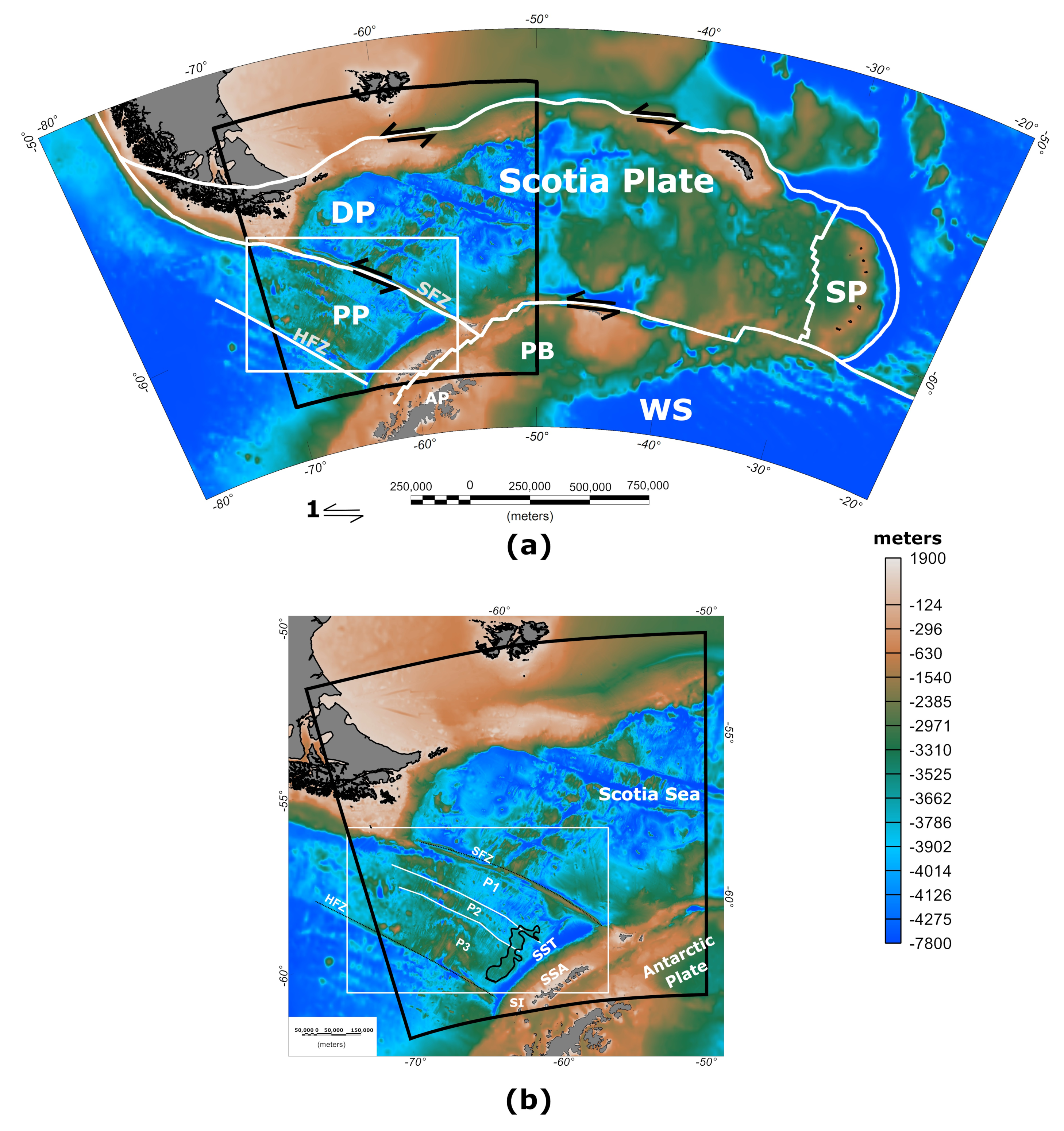
2. Materials and Methods
2.1. Data
2.1.1. Magnetic Data
2.1.2. Gravity Data
2.1.3. Bathymetry and Sediment Thickness Data
2.1.4. Magnetization Method
3. Results
3.1. Magnetic Anomaly Map
3.2. Bouguer Gravity Anomaly Map
3.3. Bathymetry Map
3.4. Magnetization Map
4. Discussion
- (i)
- It could be argued that the horizontal variation in sediment thickness could cause attenuation that locally affects the amplitude of the magnetization, at least to some extent. From the CRUST1.0 model, we studied the sediment thickness variation which shows a uniform distribution where values range between 250 m to 450 m in the study area (Figure 4). According to these results, it does not seem reasonable to attribute the decrease in magnetization amplitude to the distance from the magnetic source produced by sediment layer.
- (ii)
- Another possibility to consider for the decrease in magnetization is the decrease in the Earth’s magnetic field intensity from 14 Ma to younger ages in the oceanic corridor P1. Unfortunately, the lack of paleointensity data does not allow us to explore this option appropriately [36]. However, there are two main reasons that argue against this possibility: (1) The decrease in magnetization should be constant along each corridor, and this is not observed. In fact, within the same corridor, the decrease in magnetization occurs at younger ages to the SW and older ages to the NE. (2) The decrease in magnetization is not observed in the northern part of the spreading axis.
- (iii)
- A third scenario to explain the decrease in magnetization is related to the age of the oceanic crust. This decay is widely accepted for young oceanic crust (<20 Ma), and it is attributed to low-temperature oxidation which affects the most extrusive rocks. This way, the titanomagnetite transforms into titanomaghemite, which is less magnetic. This decrease is very quick and intense close to the spreading ridge and during the beginning of the expansion (the first 4 My). Thereafter, the transformation process becomes slower, reaching equilibrium, or, even, the magnetization exhibits a slight increase [16,37]. In the case of the Phoenix Plate, the decrease in magnetization before and after crossing the boundary (Figure 5b and Figure 7a: thick solid black and white lines, respectively) is between 30% and 50%. This is not a gradual change, and it is much higher than expected for an oceanic crust of 7 My older than the one located at the ridge for the case of corridor P1 [9].
- (iv)
- Another option to explain the decrease in magnetization is a temporal variation of chemical properties of the magnetic minerals in the basalts that form the extrusive part of the oceanic crust along the oceanic corridors [38]. Prevot and Lecaille [39] showed differences in the smallest grain size of the magnetic minerals in the axial basalts with respect to the more remote basalts. This fact can explain local contrasts (areas of several kilometers), but it is does not seem feasible since the change in magnetization pattern is not constant for the same ages in the corridors and it is not present at both sides of the spreading axis.
5. Conclusions
Author Contributions
Funding
Data Availability Statement
Acknowledgments
Conflicts of Interest
References
- Livermore, R.; Eagles, G.; Morris, P.; Maldonado, A. Shackleton Fracture Zone: No barrier to early circumpolar ocean circulation. Geology 2004, 32, 797–800. [Google Scholar] [CrossRef] [Green Version]
- Garrett, S.W.; Storey, B.C. Lithospheric Extension on the Antarctic Peninsula during Cenozoic Subduction. In Continental Extension Tectonics; Coward, M.P., Dewey, J.F., Hancock, P.L., Eds.; Geological Society, Special Publications: London, UK, 1987; Volume 28, pp. 419–431. [Google Scholar]
- Larter, R.D.; Barker, P.F. Effects of ridge crest-trench interaction on Antartic-Phoenix spreading: Forced on a young subducting Plate. J. Geophys. Res. 1991, 96, 19583–19607. [Google Scholar] [CrossRef]
- Cande, S.C.; Herron, E.M.; Hall, B.R. The early Cenozoic tectonic history of the southeast Pacific. Earth Planet. Sci. Lett. 1982, 57, 63–74. [Google Scholar] [CrossRef]
- Livermore, R.; Balanyá, J.C.; Maldonado, A.; Martinez, J.M.; Rodriguez-Fernandez, J.; Sanz de Galdeano, C.; Galindo Zaldivar, J.; Jabaloy, A.; Barnolas, A.; Somoza, L.; et al. Autopsy on a dead spreading center: The Phoenix ridge, Drake Passage, Antarctica. Geology 2000, 28, 607–610. [Google Scholar] [CrossRef] [Green Version]
- Jones, M.; Sandwell, D.; Beaman, R. New Soundings for SRTM30_Plusv7.0. In Proceedings of the Fifth Annual GEBCO Bathymetric Science Day, Callao, Peru, 15 September 2010; IHO/IOC Committee for the General Bathymetric Charts of the Ocean (GEBCO): Callao, Peru, 2010. [Google Scholar]
- Bohoyo, F.; Larter, R.D.; Galindo-Zaldívar, J.; Leat, P.T.; Maldonado, A.; Tate, A.J.; Flexas, M.M.; Gowland, E.J.M.; Arndt, J.E.; Dorschel, B.; et al. Morphological and geological features of Drake Passage, Antarctica, from a new digital bathymetric model. J. Maps 2019, 15, 49–59. [Google Scholar] [CrossRef] [Green Version]
- Maldonado, A.; Larter, R.D.; Aldaya, F. Forearc tectonic evolution of the South Shetland margin, Antartic Peninsula. Tectonics 1994, 13, 1345–1370. [Google Scholar] [CrossRef]
- Eagles, G. Tectonic evolution of the Antarctic-Phoenix plate system since 15 Ma. Earth Planet. Sci. Lett. 2003, 217, 97–109. [Google Scholar] [CrossRef] [Green Version]
- Jin, Y.K.; Kim, K.J.; Hong, J.K.; Park, M.; Nam, S.H.; Lee, J.H.; Kim, Y.D. Geophysical Investigations of P3 Segment of the Phoenix Ridge in Drake Passage, Antarctica, in Antarctica: A Keystone in a Changing World-Online. In Proceedings of the 10th ISAES X, Santa Barbara, CA, USA, 26 August–1 September 2007; Cooper, A.K., Raymond, C.R., Eds.; National Academies Press: Washington, DC, USA, 2007; Volume 4. [Google Scholar]
- Nuñez Demarco, P.; Prezzi, C.; Sanchez Bettucci, L. Review of Curie point depth determination through different spectral methods applied to magnetic data. Geophys. J. Int. 2021, 224, 17–39. [Google Scholar] [CrossRef]
- Dunlop, D.J.; Özdemir, Ö. Rock Magnetism: Fundamentals and Frontiers; Cambridge University Press: Cambridge, UK, 1997; 573p. [Google Scholar]
- Chiozzi, P.; Matsuschima, J.; Okubo, Y.; Pasquale, V.; Verdoya, M. Curie point depth form spectral analysis of magnetic data in central-southern Europe. Phys. Earth Planet. Inter. 2005, 152, 267–276. [Google Scholar] [CrossRef]
- Eppelbaum, L.V.; Pilchin, A.N. Methodolgy of Curie discontinuity map development for regions with low thermal characteristics: An example from Israel. Earth Planet. Sci. Lett. 2006, 243, 536–551. [Google Scholar] [CrossRef]
- Tivey, M.; Johnson, H.P. Crustal magnetization reveals subsurface structure of Juan de Fuca Ridge hydrothermal vent fields. Geology 2002, 30, 979–982. [Google Scholar] [CrossRef]
- Tivey, M.; Tucholke, B.E. Magnetization of 0–29 Ma ocean crust on the Mid-Atlantic Ridge, 25°30′ to 27°10′ N. J. Geophys. Res. 1998, 103, 17807–17826. [Google Scholar] [CrossRef] [Green Version]
- Choe, H.; Dyment, J. Decreasing magnetization, lithospheric flexure and rejuvenated hydrothermalism off the Japan-Kuril subduction zone. Geophys. Res. Lett. 2020, 47, 1–7. [Google Scholar] [CrossRef]
- Choe, H.; Dyment, J. The fate of marine magnetic anomaly in subduction zones: A global appraisal. Earth Planet. Sci. Lett. 2021, 561, 116787. [Google Scholar] [CrossRef]
- Quesnel, Y.; Catalán, M.; Ishihara, T. A new global marine magnetic anomaly data set. J. Geophys. Res. 2009, 114, B04106. [Google Scholar] [CrossRef]
- Catalán, M.; Dyment, J.; Choi, Y.; Hamoudi, M.; Lesur, V.; Thebault, E.; de Santis, A.; Ishihara, T.; Korhonen, J.; Litvinova, T.; et al. Making a better magnetic map. Eos 2016, 97, 1–9. [Google Scholar] [CrossRef]
- Lesur, V.; Hamoudi, M.; Choi, Y.; Dyment, J.; Thèbault, E. Building the second version of the World Digital Magnetic Anomaly Map (WDMAM). Earth Planets Space 2016, 68, 27. [Google Scholar] [CrossRef]
- Sabaka, T.J.; Olsen, N.; Purucker, M.E. Extending comprehensive models of the Earth’s magnetic field with Oersted and CHAMP data. Geophys. J. Int. 2004, 159, 521–547. [Google Scholar] [CrossRef]
- Thébault, E.; Finlay, C.C.; Beggan, C.; Alken, P.; Aubert, J.; Barrois, O.; Bertrand, F.; Bondar, T.; Boness, A.; Brocco, L.; et al. International Geomagnetic Reference Field: The 12th generation. Earth Planet. Space 2015, 67, 79. [Google Scholar] [CrossRef]
- Kuhn, M.; Featherstone, W.E.; Kirby, J.F. Complete spherical Bouguer gravity anomalies over Australia. Aust. J. Earth Sci. Int. Geosci. J. Geol. Soc. Aust. 2009, 56, 213–223. [Google Scholar] [CrossRef]
- Bonvalot, S.; Balmino, G.; Briais, A.; Kuhn, M.; Peyrefitte, A.; Vales, N.; Biancale, R.; Gabalda, G.; Reinquin, F.; Sarrailh, M. World Gravity Map; Commission for the Geological Map of the World, Ed.; BGI-CGMW-CNES-IRD: Paris, France, 2012. [Google Scholar]
- Pavlis, N.K.; Holmes, S.A.; Kenyon, S.C.; Factor, J.K. An Earth Gravitational Model to degree 2160: EGM2008. In Proceedings of the General Assembly of the European Geosciences Union, Vienna, Austria, 13–18 April 2008. [Google Scholar]
- Balmino, G.; Vales, N.; Bonvalot, S.; Briais, A. Spherical harmonic modeling to ultra-high degree of Bouguer and isostatic anomalies. J. Geod. 2012, 86, 499–520. [Google Scholar] [CrossRef]
- Amante, C.; Eakins, B.W. ETOPO1 1 Arc-Minute Global Relief Model: Procedures, Data Sources and Analysis. In NOAA Technical Memorandum NESDIS NGDC-24; National Geophysical Data Center Marine Geology and Geophysics Division: Boulder, CO, USA, 2009. [Google Scholar]
- Laske, G.; Masters, G.; Ma, Z.; Pasyanos, M. Update on CRUST1.0—A 1-degree Global Model of Earth’s crust. Geophys. Res. Abstr. 2013, 15, 2658. [Google Scholar]
- Parker, R.L.; Huestis, S.P. The inversion of magnetic anomalies in the presence of topography. J. Geophys. Res. 1974, 79, 1587–1593. [Google Scholar] [CrossRef]
- Garrett, S.W. Interpretation of reconnaissance gravity and aeromagnetic surveys of the Antartic Peninsula. J. Geophys. Res. 1990, 95, 6759–6777. [Google Scholar] [CrossRef]
- Ghidella, M.E.; Yánez, G.; LaBreque, J.L. Revised tectonic implications for the magnetic anomalies of the western Weddell Sea. Tectonophysics 2002, 347, 65–86. [Google Scholar] [CrossRef]
- Suriñach, E.; Galindo-Zaldívar, J.; Maldonado, A.; Livermore, R. Large amplitude magnetic anomalies in the northern sector of the Powell Basin, NE Antarctic Peninsula. Mar. Geophys. Res. 1997, 19, 65–80. [Google Scholar]
- Hayes, G.P.; Wald, D.J.; Johnson, R.L. Slab1.0: A three-dimensional model of global subduction zone geometries. J. Geophys. Res. Solid Earth 2012, 117, 1–15. [Google Scholar] [CrossRef]
- Johnson, P.H.; Pruis, M.J.; Van Patten, D.; Tivey, M.A. Density and porosity of the upper oceanic crust from seafloor gravity measurements. Geophys. Res. Lett. 2000, 27, 1053–1056. [Google Scholar] [CrossRef] [Green Version]
- Juárez, M.T.; Tauxe, L.; Gee, J.S.; Pick, T. The intensity of the Earth’s magnetic field over the past 160million years. Nature 1998, 394, 878–881. [Google Scholar] [CrossRef] [Green Version]
- Pockalny, R.A.; Smith, A.; Gente, P. Spatial and temporal variability of crustal magnetization of a slowly spreading ridge: Mid_Atlantic Ridge (20°–24° N). Mar. Geophys. Res. 1995, 17, 301–320. [Google Scholar] [CrossRef]
- Tivey, M.A.; Johnson, H.P. The Central Anomaly high: Implications for ocean crust construction and evolution. J. Geophys. Res. 1987, 92, 12685–12694. [Google Scholar] [CrossRef]
- Prevot, M.; Lecaille, A. Comments on paper by Klitgord, K.D. Sea-floor spreading: The central anomaly Magnetization High. Earth Planet. Sci. Lett. 1976, 33, 164–168. [Google Scholar] [CrossRef]
- Martos, Y.M.; Catalán, M.; Galindo-Zaldívar, J. Curie depth, heat flux and thermal subsidence studies reveal the Pacific mantle outflow through the Scotia Sea. J. Geophys. Res. Solid Earth 2019, 124, 10735–10751. [Google Scholar] [CrossRef]
- Martos, Y.M.; Maldonado, A.; Lobo, F.J.; Hernández-Molina, F.J.; Pérez, L.F. Tectonics and palaeoceanographic evolution recorded by contourite features in southern Drake Passage (Antarctica). Mar. Geol. 2013, 343, 76–91. [Google Scholar] [CrossRef]
- Martos, Y.M.; Galindo-Zaldívar, J.; Catalán, M.; Bohoyo, F.; Maldonado, A. Asthenospheric Pacific–Atlantic flow barriers and the west Scotia ridge extinction. Geophys. Res. Lett. 2014, 41, 1–7. [Google Scholar] [CrossRef]
- Vuan, A.; Sugan, M.; Plasencia Linares, M.P. Reappraisal of surface wave group velocity tomography in the Subantarctic Scotia Sea and surrounding ridges. Glob. Planet. Chang. 2014, 123, 223–238. [Google Scholar] [CrossRef]
- Vuan, A.; Russi, M.; Panza, G.F. Group velocity tomography in the sub-antarctic Scotia Sea region. Pure Appl. Geophys. 2000, 157, 1337–1357. [Google Scholar] [CrossRef]
- Zhou, W.; Van der Voo, R.; Peacor, D.R.; Wang, D.; Zhang, Y. Low-temperature oxidation in MORB of titanomagnetite to titanomaghemite: A gradual process with implications for marine magnetic anomaly amplitudes. J. Geophys. Res. 2001, 106, 6409–6421. [Google Scholar] [CrossRef]
- Ranero, C.R.; Phipps Morgan, J.; McIntosh, K.; Reichert, C. Bending-related faulting and mantle serpentinization at the Middle America trench. Nature 2003, 425, 367–373. [Google Scholar] [CrossRef]
- Contreras-Reyes, E.; Grevemeyer, I.; Flueh, E.R.; Scherwath, M.; Bialas, J. Effect of trench-outer rise bending-related faulting on seismic Poisson’s ratio and mantle anisotropy: A case study offshore of Southern Central Chile. J. Geophys. J. Int. 2008, 173, 142–156. [Google Scholar] [CrossRef] [Green Version]
- Ivandic, M.; Grevemeyer, I.; Bialas, J.; Petersen, C.J. Serpentinization in the trench-outer rise region offshore of Nicaragua: Constraints from seismic fraction and wide-angle data. Geophys. J. Int. 2010, 180, 1253–1264. [Google Scholar] [CrossRef] [Green Version]

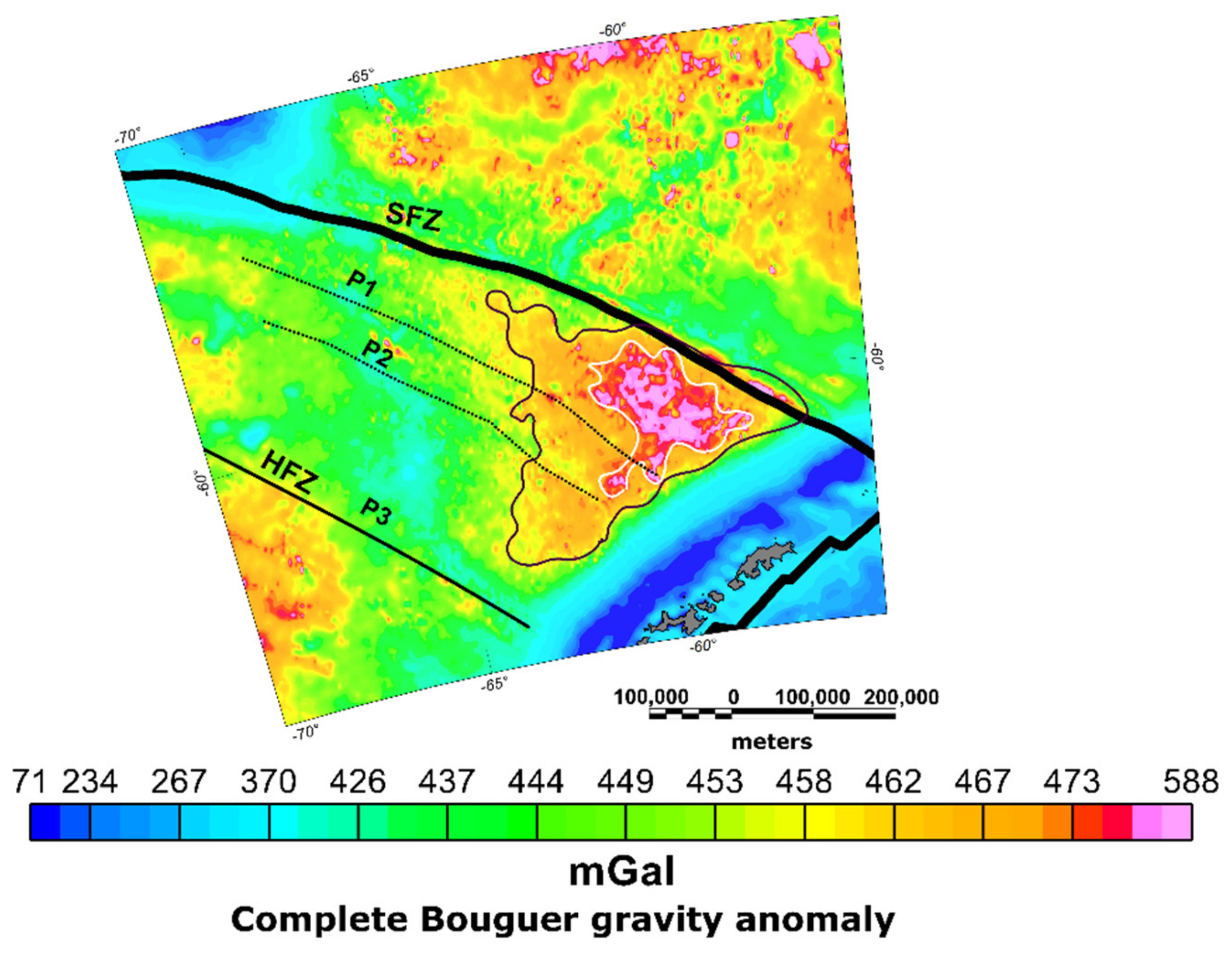

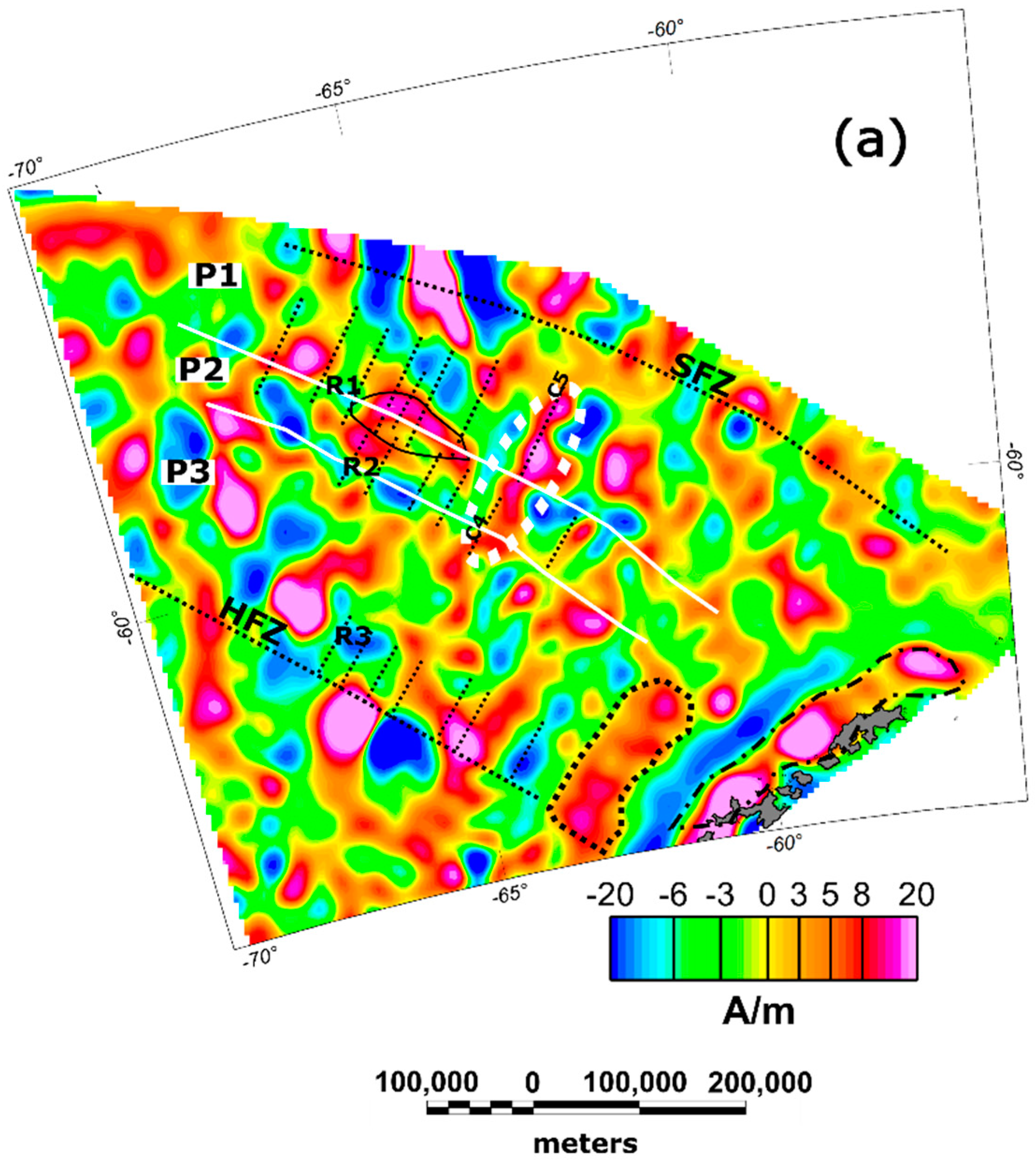

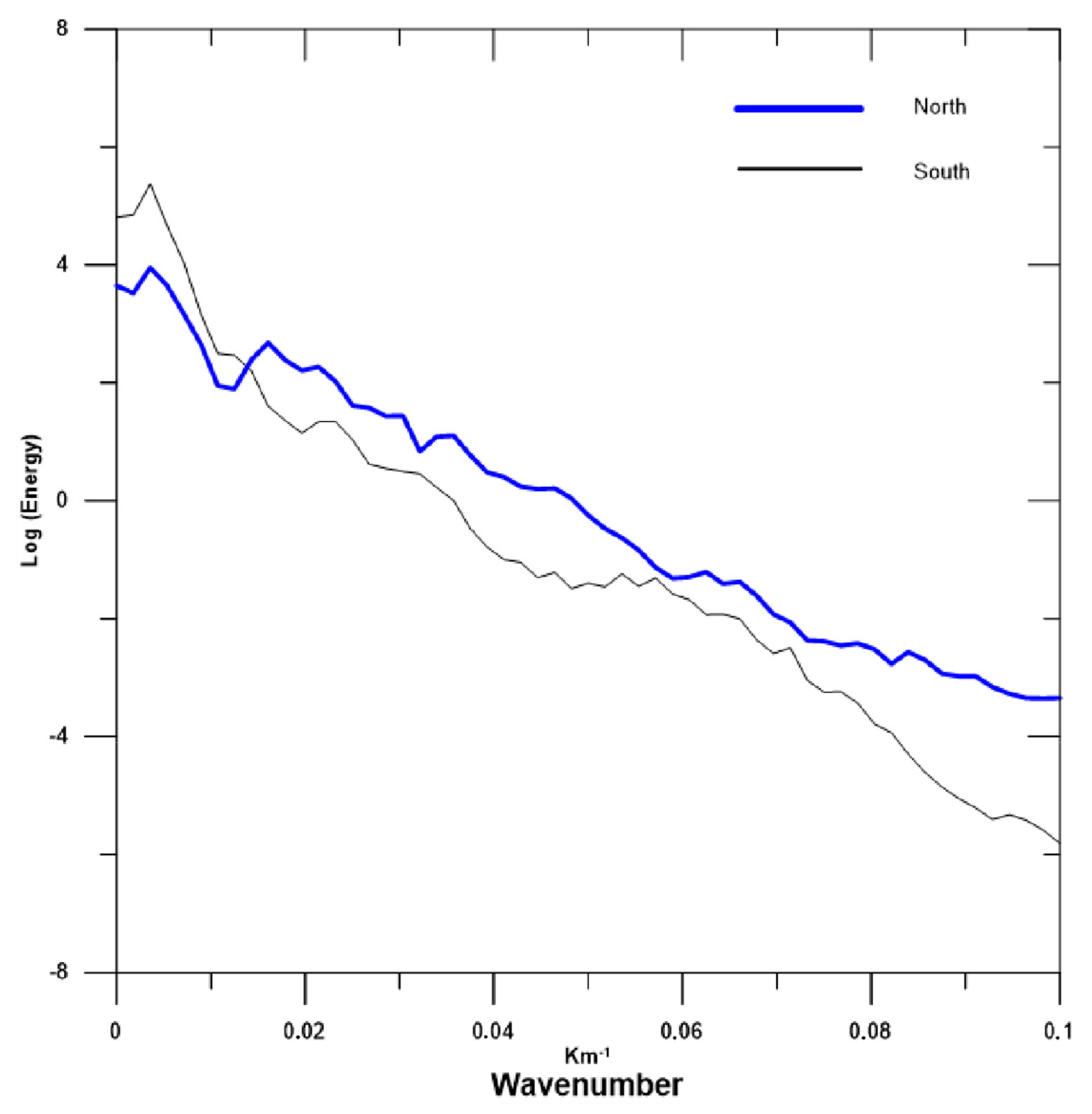
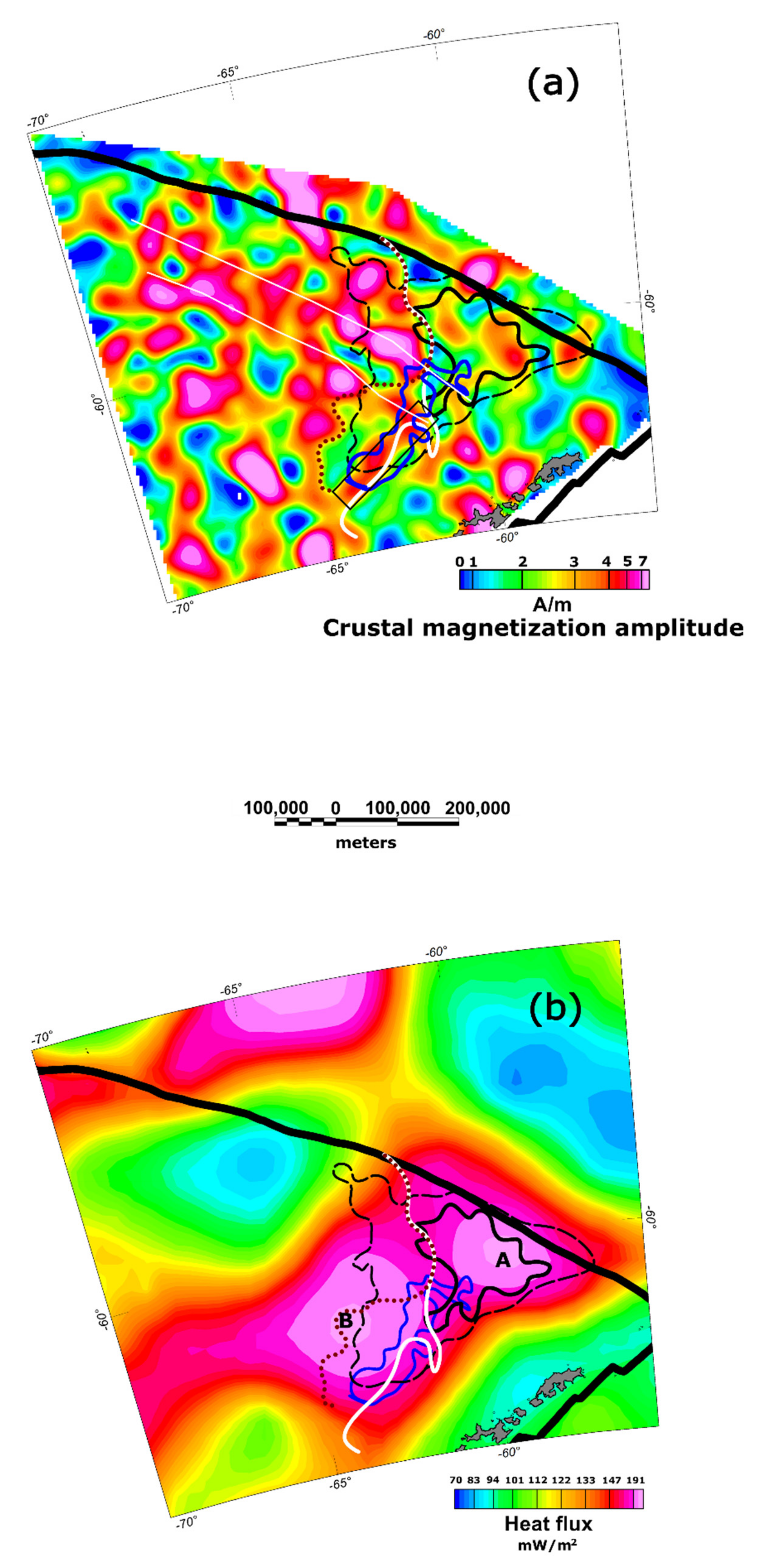
Publisher’s Note: MDPI stays neutral with regard to jurisdictional claims in published maps and institutional affiliations. |
© 2022 by the authors. Licensee MDPI, Basel, Switzerland. This article is an open access article distributed under the terms and conditions of the Creative Commons Attribution (CC BY) license (https://creativecommons.org/licenses/by/4.0/).
Share and Cite
Catalán, M.; Martos, Y.M. New Evidence Supporting the Pacific Mantle Outflow: Hints from Crustal Magnetization of the Phoenix Plate. Remote Sens. 2022, 14, 1642. https://doi.org/10.3390/rs14071642
Catalán M, Martos YM. New Evidence Supporting the Pacific Mantle Outflow: Hints from Crustal Magnetization of the Phoenix Plate. Remote Sensing. 2022; 14(7):1642. https://doi.org/10.3390/rs14071642
Chicago/Turabian StyleCatalán, Manuel, and Yasmina M. Martos. 2022. "New Evidence Supporting the Pacific Mantle Outflow: Hints from Crustal Magnetization of the Phoenix Plate" Remote Sensing 14, no. 7: 1642. https://doi.org/10.3390/rs14071642
APA StyleCatalán, M., & Martos, Y. M. (2022). New Evidence Supporting the Pacific Mantle Outflow: Hints from Crustal Magnetization of the Phoenix Plate. Remote Sensing, 14(7), 1642. https://doi.org/10.3390/rs14071642






